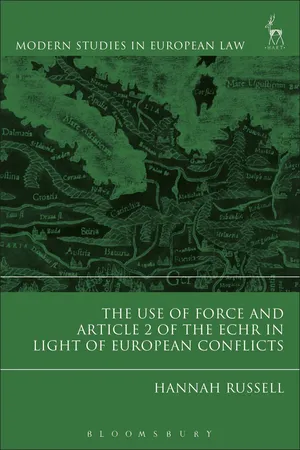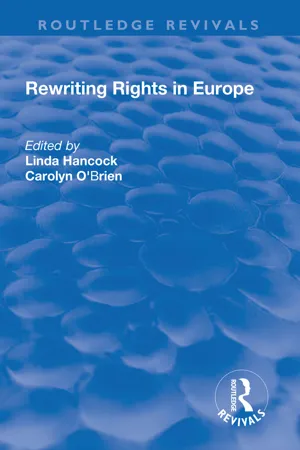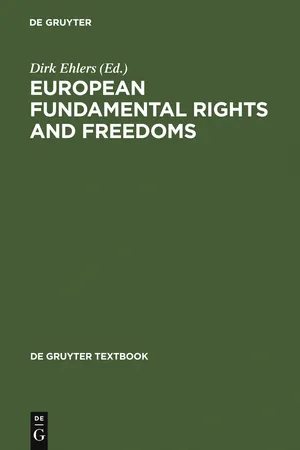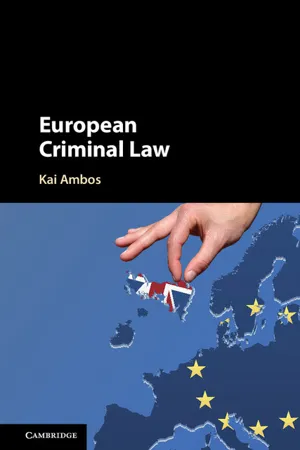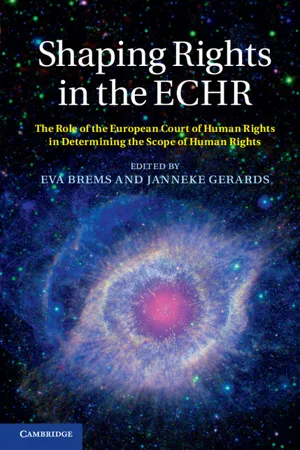Law
Article 2 echr
Article 2 of the European Convention on Human Rights (ECHR) protects the right to life, stating that no one shall be deprived of their life intentionally except in the execution of a sentence of a court following conviction of a crime. This provision also imposes a duty on the state to take appropriate measures to safeguard individuals' lives.
Written by Perlego with AI-assistance
Related key terms
1 of 5
9 Key excerpts on "Article 2 echr"
- Hannah Russell(Author)
- 2017(Publication Date)
- Hart Publishing(Publisher)
The protections set out within Article 2 extend to all persons within the jurisdic- tion of the state that is bound by it. This includes suspected or known terrorists/ rebels, the state security forces and the state military. Exceptions extend to situa- tions where lawful acts of war occur and IHRL is superseded by IHL, but outside of such scenarios Article 2 principles must apply. 11 The HCPs to the ECHR are 11 Art 15(2), ECHR. The Right to Life in Europe 15 12 D Xenos, The Positive Obligations of the State Under the ECHR (Routledge, 2011) 2. 13 ibid. 14 JF Akandji-Kombe, Positive Obligations Under the ECHR: A Guide to the Implementation of the ECHR (CoE, 2007) 11. 15 ibid. responsible for ensuring that Article 2 is adhered to and protected. They are sub- ject to the obligations and limitations set out within. These are not immediately obvious from the text of Article 2. Thus a set of guidelines, clarifying what the right to life demands of states, should be introduced. A. Obligations Four obligations can be identified in Article 2 of the ECHR: 1) the right to life must be protected by law; 2) the duty to refrain from an unjustified killing; 3) the duty to protect people against real and immediate risks; and 4) the duty to thoroughly investigate deaths. Each of these contains a number of requirements. These requirements vary depending on the context and are not clear from the text of Article 2. They are developed by the ECtHR’s jurisprudence. Therefore, the proposed guidelines draw from the wording of the ECHR and its partnering case law. The four obligations can be divided into categories of negative and positive. Human rights violations by the state ‘are the exception rather than the rule’, and our understanding of an entitlement to human rights has developed into an ‘entitlement to enjoy human rights and not merely an entitlement to their non- violation by State agents’. 12 The latter, more traditional duty equates to negative obligations.- eBook - PDF
European Convention on Human Rights
Commentary
- Christoph Grabenwarter(Author)
- 2014(Publication Date)
- Beck/Hart(Publisher)
6 Article 2 – Right to Life Art. 2 12 V. Positive obligations ............................................................. 16 1. Obligation to protect life ................................................... 17 2. Organisational and procedural obligations .............................. 21 I. Introduction 1 The right to life is guaranteed under Article 2 of the ECHR. Its position on top of the catalogue of human rights reflects its relevance as one of the most fundamental provisions in the Convention. 1 The Court places the emphasis on the importance of this guarantee by its declaration that the ‘ right to life enshrines one of the basic values of the democratic societies making up the Council of Europe ’ . 2 Furthermore, this is illustrated by the fact that Article 2 belongs to the ‘ non-derogable ’ rights. No derogation is permitted in any circumstances under Article 15. 3 The first sentence of Article 2 (1) covers the protection of life of every human being. It imposes an extensive obligation on the State to safeguard the lives of those within its jurisdiction. 4 Article 2 (1) second sentence and paragraph 2 are primary directed against interferences by the State . 5 Article 2 (1) second sentence enjoins the State to refrain from the intentional and unlawful taking of life. This prohibition is restricted by the one exception of the execution of a death sentence. In connection with the prohibition of intentional taking of life covered in paragraph 1, three other exceptions are constituted in Article 2 (2) under (a) to (c), which relate to both intentional and unintentional killing. 6 Thus, a deprivation of life shall not be regarded as inflicted in contravention of this Article when it results from the use of force which is no more than absolutely necessary. Recent case law paints a disturbing picture of the protection of life in Turkey 7 and Russia. - Kjetil Mujezinović Larsen(Author)
- 2012(Publication Date)
- Cambridge University Press(Publisher)
If there are obligations that the state is in no position to satisfy, it should not be bound by these obligations. This would, admittedly, lead to uncertainties about the scope of applicable obligations, but this nevertheless seems preferable compared to the inflexible ‘all-or-nothing’ approach suggested in the Bankovi´ c case. A final argument in support of this principle is that in order to find realistic solutions to complex problems, one must consider the realistic, factual circumstances. A complex situation may, inevitably, require a complex solution. To respond to the complex situation in UN-mandated peace operations by saying, as the Court does, that the ECHR cannot apply at all, is unnecessary and over-simplified. The right to life The relevant treaty provisions Article 2 echr reads: 1. Everyone’s right to life shall be protected by law. No one shall be deprived of his life intentionally save in the execution of a sentence of a court following his conviction of a crime for which this penalty is provided by law. 2. Deprivation of life shall not be regarded as inflicted in contravention of this article when it results from the use of force which is no more than absolutely necessary: a. in defence of any person from unlawful violence; the application of substantive provisions 375 b. in order to effect a lawful arrest or to prevent the escape of a person lawfully detained; c. in action lawfully taken for the purpose of quelling a riot or insurrection. The corresponding provision in the ICCPR, Article 6.1, reads: Every human being has the inherent right to life. This right shall be protected by law. No one shall be arbitrarily deprived of his life. During the negotiations prior to the ICCPR it was held that the term ‘arbitrarily’ covers more than cases of ‘intentional’ killing, and that the term made it unnecessary to list the cases in which deprivation of life could be justified.- eBook - ePub
- Howard Davis(Author)
- 2014(Publication Date)
- Routledge(Publisher)
The importance of ‘life’ is already recognised. The point of human rights law is to require states to protect the right to life that is already established in human custom and in religious or moral beliefs. The UN’s International Covenant on Civil and Political Rights (ICCPR), for instance, says that ‘Every human being has the inherent right to life’. Similarly the first sentence of Article 2 echr says — ‘Everyone’s right to life shall be protected by law’. Article 2, therefore, imposes on states a range of negative and positive duties required to guarantee that the right to life is respected. No Intentional killing Article 2 is explicit about these duties in one respect. The second sentence says that ‘no one shall be deprived of his life intentionally …’. Thus states must have laws which define ‘murder’ and which provide the means by which it can be investigated, prosecuted and punished. In particular, state agents (such as police, security services and the military) must not intentionally kill, except in very limited circumstances which are discussed below. Warfare, of course, involves intentional killing. As a general rule states cannot use lethal force (force intending to kill) just because the country is facing a state of emergency. Suspending or ‘derogating’ from rights, which is allowed if done consistently with Article 15, is not generally permissible for Article 2 (derogation is discussed in Chapter 4) - eBook - ePub
- Linda Hancock, Carolyn O'Brien(Authors)
- 2017(Publication Date)
- Routledge(Publisher)
United Kingdom , 1998, paras 22 and 24).This privatisation of human rights has yet to develop fully, but it will likely be a growth area in the jurisprudence of the European Court of Human Rights and the domestic courts over the next decade or two (Clapham, 1995). Furthermore, such evolution will be affected by the continuing development of the relationship between European Union law and the ECHR, as the former applies both to horizontal and vertical legal relations. The impact that the ECHR will have on the Member States of the European Union (all 15 of which are signatories of the ECHR) is especially likely to increase as the ECHR is embraced ever more tightly by the more elaborate and directly effective legal regime of the European Union. In this regard, Article F of the 1993 Treaty on European Union (TEU) directs all organs of the EU to have regard for and to promote the ECHR. Indeed, there have been a number of decisions of the European Court of Justice, both before and after the coming into force of Article F of the TEU, that bear directly on the relationship between Community law and provisions of the ECHR (Stauder v Ulm , 1969; Internationale Handelsgesellschaft v EVG , 1970; Nold v Commission , 1972; Rutili v French Minister of the Interior , 1975).9 The Court's use of the Convention is set to increase markedly following the direct inclusion of Article F within the express justiciable bounds of the Court by an amendment introduced by the Treaty of Amsterdam 1997.10 - eBook - PDF
- Dirk Ehlers, Ulrich Becker, Et al., Dirk Ehlers(Authors)
- 2011(Publication Date)
- De Gruyter(Publisher)
4 I. The Protection of Liberty (Article 5 ECHR) Lead by the structure of regulation used in the Basic Law, the content of Article 5 of the ECHR can be divided into three parts. Article 5(1)(i) of the ECHR contains the general guarantee of individual liberty (comparable to Article 2(2)(ii) of the Basic Law), the second sentence of paragraph 1 includes the conditions governing the legality of certain acts of interference (comparable to Article 104(1) of the Basic Law), while finally Ar-ticle 5(2) to (5) of the ECHR comprises particular procedural guarantees related to depri-vations of liberty (comparable to Article 104(2) and (3) of the Basic Law). In Article II-66, the Treaty establishing a Constitution for Europe (Draft Constitution – DC) recogni ses the right to liberty and security. 5 151 1 2 3 1 Current judgements of the European Court of Human Rights can be retrieved from the internet under http://www.echr.coe.int/. 2 For example cf Grabenwarter in: Cremer (ed) Tradition und Weltoffenheit des Rechts (Berlin 2002) pp 1129–1131. 3 BVerfG (1987) 74 BVerfGE 358, 370; (1991) 82 BVerfGE 106, 115. 4 Grabenwarter Verfahrensgarantien in der Verwaltungsgerichtsbarkeit (Vienna 1997) pp 696 ff. 5 Concerning the extent of guarantee cf Grabenwarter [2001] DVBl 1, 4. 1. The Right to Liberty and Security The scope of protection of Article 5 of the ECHR comprises – apart from the prohibition of arbitrary arrest and deprivation of liberty (subsection 1) 6 – the guarantee of a judicial control of deprivation of liberty. Article 5 of the ECHR is also applicable to short-term deprivation of liberty. 7 When judging whether a deprivation of liberty in the sense of Article 5 of the ECHR exists, the concrete situation of the individuals affected must be taken into account. 8 Although the terms “liberty and security” are listed separately in Article 5(1) of the ECHR, the right to security has only gained minor significance of its own. - eBook - PDF
- Kai Ambos(Author)
- 2018(Publication Date)
- Cambridge University Press(Publisher)
2, cf. Ariav, GoJIL, 4 (2012), 857–8; Grabenwarter, ECHR (2014), Art. 8 mn. 22– 3, 25. Cf. also Schilling, Internationaler Menschenrechtsschutz (2016), §7 mn. 145 ff. (who also touches upon the problems ensuing as part of regime change (mn. 147)). 608. Cf. recently ECtHR, M. Tunç and F. Tunç v. Turkey, No 24014/05, GC Judgment (14 April 2015), paras. 169 ff. (171: ‘Article 2 imposes a duty on that State to secure the right to life . . . [and] requires by implication that there should be some form of effective official investigation when there is reason to believe that an individual has sustained life-threatening injuries in suspicious circumstances, even where the presumed perpetrator of the fatal attack is not a State agent’). The Chamber took an outcome-oriented approach with regard to the independent nature of the investigation focusing on its efficiency (ibid., para. 223 (‘Article 2 does not require that the persons and bodies responsible for the investigation enjoy absolute inde- pendence, but rather that they are sufficiently independent’), and para. 225 (‘com- pliance with the procedural requirement of Article 2 is assessed on the basis of several essential parameters . . . which, taken jointly, enable the degree of effective- ness of the investigation to be assessed. It is in relation to this purpose of an effective investigation that any issues, including that of independence, must be assessed’)), thereby deviating from the absolutist approach of the former case law (e.g. ECtHR, Al-Skeini et al. v. the UK, No 55721/07, GC Judgment (7 July 2011), paras. 166–7 (167: ‘it is necessary for the persons responsible for and carrying out the investiga- tion to be independent from those implicated in the events. This means not only a lack of hierarchical or institutional connection but also a practical independence’); ECtHR, Mocanu et al., 10865/09, 45886/07 and 32431/08, paras. 320 ff.); thereon Kukavica and Fikfak, CLJ, 74 (2015), 415 ff. - eBook - PDF
The EU Charter of Fundamental Rights
A Commentary
- Steve Peers, Tamara Hervey, Jeff Kenner, Angela Ward, Steve Peers, Tamara Hervey, Jeff Kenner, Angela Ward(Authors)
- 2014(Publication Date)
- Hart/Beck(Publisher)
On the meaning of a ‘reasonable time’ in EU and ECHR law, see section D.VIII. 44 Adopted 21 December 1965, entered into force 4 January 1969, 660 UNTS 195. 47.33 47.34 47.35 47.36 Part I – Commentary on the Articles of the EU Charter 1208 Dinah Shelton just and adequate reparation or satisfaction for any damage suffered as a result of such discrimination. The language of this provision anticipates the use of injunctive or other preventive measures against discrimination, as well as compensation or other remedies for consequential damages. A similar provision requiring effective protection of women from discrimination is found in Article 2(c) of the Convention on the Elimination of All Forms of Discrimination against Women. 45 The Universal Declaration of Human Rights and several global and regional treaties similarly refer to the right to legal protec-tion for attacks on privacy, family, home or correspondence, or attacks on honour and reputation. The European Convention requires a fair hearing before an independent tribunal for determination of all civil rights and obligations and any criminal charge. According to the European Court of Human Rights, Article 13 does not necessarily require judicial remedies. See for example Klass and Others v Germany, 46 where it was held that Article 13 guarantees an effective remedy ‘to everyone who claims that his rights and freedoms under the Convention have been violated’. - eBook - PDF
Shaping Rights in the ECHR
The Role of the European Court of Human Rights in Determining the Scope of Human Rights
- Eva Brems, Janneke Gerards(Authors)
- 2014(Publication Date)
- Cambridge University Press(Publisher)
Another issue concerns so-called ‘human rights inflation’, a term that is generally used to criticise the fact that the Court is allegedly reading ‘new’ human rights into the ECHR, especially through the extensive ‘cre- ation’ of positive obligations. 66 This criticism stems from the symmetrical nature of rights and obligations – a right for an individual corresponds to an obligation on the state and vice versa. 67 Take the example of the environmental cases: the individual’s right to respect for private life or home may take on a particular significance in cases of environmental nuisance, in some of which cases results in a particular definitive positive obligation on the authorities to protect that right. The Court does not create an abstract ‘right to a clean and quiet environment’ thereby, 68 let 63 Cf. Smet’s chapter in this volume. 64 For example Christoffersen, note 48 above, p. 107. In Christoffersen’s words, ‘the scope of the positive obligation is subject to balancing’. He explains this by the example of the preventive positive obligation under Art. 2 ECHR, where the scope of the positive obligation depends on the question whether the authorities took ‘measures within the scope of their powers which, judged reasonably, might have been expected to avoid that risk’. 65 Xenos, note 49 above, p. 4. 66 For example G. Letsas, A Theory of Interpretation of the European Convention on Human Rights (Oxford University Press, 2007), pp. 126–30. Also see the concerns expressed by Gerards in her chapter in this volume. 67 Alexy, note 8 above, p. 296. 68 Discussing Hatton, note 18 above, Gerards and Senden deplore the fact that the Court ‘did not address the more abstract question of whether a right to a clean and quiet environment 174 laurens lavrysen alone an abstract ‘right to sleep’, 69 since Article 8 ECHR only protects the right to respect for private life and the home.
Index pages curate the most relevant extracts from our library of academic textbooks. They’ve been created using an in-house natural language model (NLM), each adding context and meaning to key research topics.
